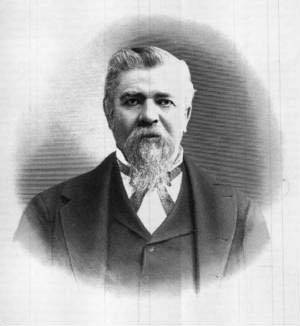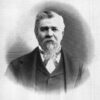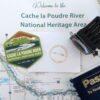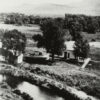
Benjamin Eaton grew up in Ohio in the 1830s and 1840s. Upon reaching adulthood, he undertook a series of tasks and adventures that prepared him well for the future role he would play in settling the Poudre River Valley. While still in Ohio, he was a surveyor assistant on the new railroads passing near his family’s farm. He moved to Oakland Township in Louisa County, Iowa, in 1854 where he taught school and initially farmed on shares. He joined the Columbus City, Iowa, Pikes Peak Expedition in spring 1859 that departed for the Colorado gold fields. The group followed the South Platte River into Colorado, camping one night at the mouth of the Poudre River.
That summer, the Iowans searched for gold, encountering the rules and technology being used in the mining districts which permitted everyone to join the search for gold. The Miner’s Codes allocated land and water in a first-in-time, first-in-right manner, making sure that each took only the amount of land and water that he/she could actively utilize. Ditches were dug to move the water out of the streams to the sluiceways. The mining camps had a great need for hay (fuel) for the horsepower needed to keep the mining operations active. Observing this scene and noting its function and needs would serve Eaton well later in life.
After six months, all members of the Columbus City Expedition, except Eaton, returned to Iowa. He decided to check out other mining camps and met another Iowan, Jim Hill, from Wappelo, Iowa – a community less than 20 miles from Eaton’s Iowa farm. In December 1860, Eaton and Hill joined the Second Baker Expedition to search for gold in the San Juan Mountains in southwestern Colorado. The effort was unsuccessful with miners dispersing. Eaton and Hill passed through Fort Garland on their way south where they observed the Hispanic irrigation developments. They begin farming on shares at the Maxwell Land Grant, in Cimarron, New Mexico, working within the acequia system for constructing, maintaining and operating an irrigation ditch.
In late summer 1863, Eaton and Hill departed Cimarron, heading toward Denver, with the intent of visiting Iowa (and, for Eaton, Ohio) before returning to Colorado to homestead. Where to homestead? Before heading east, employed as drivers of freight wagons, they returned to the mouth of the Poudre and camped, again. About 12 miles up the Poudre, where the valley widened and natural hay meadows existed, they staked their claims with a hastily constructed claim ‘shack’.
In March, 1864, Eaton marries Rachel Hill, Jim Hill’s sister. Early summer they depart Iowa for Colorado via covered wagon, to take up the homestead claims made the previous fall. As they travel up the Poudre River in July 1864, Eaton notes the extremely lush native hay meadows at their homestead. Their arrival occurred a little more than one month after the flood that forced the military to move their camp from Laporte to a new site – Fort Collins. Eaton realized, that July, that he could make a large sum of money transporting the large supply of hay from his farm to mining camps – camps he knew well.
Over the next six years, Eaton constructs the B.H. Eaton ditch to water his hay meadows at times other than nature’s one natural irrigation each spring. He establishes a prosperous farm and helps the growing community build its first schoolhouse along the banks of the Whitney Ditch, just north of the Poudre River, southwest of today’s downtown Windsor.
In late 1869 Eaton learns of Nathan Meeker’s and Horace Greeley’s plans to create the Union Colony in the general area of the Poudre River. Eaton suggests the broad area around where the Box Elder Creek enters the Poudre River (near the Council Tree). However, Meeker decides to locate the Colony where the new train tracks cross the Poudre River, and about five miles from where it empties into the South Platte River.
Thus, Eaton had experience with surveying, moving water away from rivers via canals/ditches, and procedures Hispanics and miners use to allocate water among competing users. This, along with his strong initiative, puts him in an excellent position make major contributions to Colorado’s water infrastructure and, in turn, creation of Colorado water law.
Photo Credit:
Archive at Fort Collins Museum of Discovery c. 1911
References:
Norris, Jane E. and Lee G. 1990. Written in water: the life of Benjamin Harrison Eaton. Ohio University Press, Athens.
Hobbs, Greg. 1997. Colorado Water Law: An Historical Overview. Vol 1(1): Water Law Review, University of Denver, Denver Colorado [http://duwaterlawreview.com/wp-content/uploads/2013/03/1UDenvWaterLRev1.pdf]







